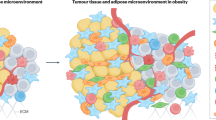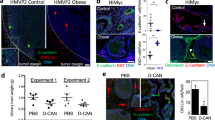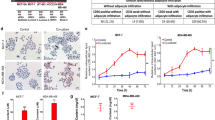Abstract
Background/Objectives:
Obesity (body mass index (BMI)⩾30 kg m−2) is associated with an increased risk of estrogen-dependent breast cancer after menopause. Levels of aromatase, the rate-limiting enzyme in estrogen biosynthesis, are elevated in breast tissue of obese women. Recently, the regulation of aromatase by the p53-hypoxia-inducible factor-1α (HIF1α)/pyruvate kinase M2 (PKM2) axis was characterized in adipose stromal cells (ASCs) of women with Li–Fraumeni Syndrome, a hereditary cancer syndrome that predisposes to estrogen-dependent breast cancer. The current study aimed to determine whether stimulation of aromatase by obesity-associated adipokine leptin involves the regulation of the p53-HIF1α/PKM2 axis.
Subjects/Methods:
Human breast ASCs were used to characterize the p53-HIF1α/PKM2-aromatase axis in response to leptin. The effect of pharmacological or genetic modulation of protein kinase C (PKC), mitogen-activated protein kinase (MAPK), p53, Aha1, Hsp90, HIF1α and PKM2 on aromatase promoter activity, expression and enzyme activity was examined. Semiquantitative immunofluorescence and confocal imaging were used to assess ASC-specific protein expression in formalin-fixed paraffin-embedded tissue sections of breast of women and mammary tissue of mice following a low-fat (LF) or high-fat (HF) diet for 17 weeks.
Results:
Leptin-mediated induction of aromatase was dependent on PKC/MAPK signaling and the suppression of p53. This, in turn, was associated with an increase in Aha1 protein expression, activation of Hsp90 and the stabilization of HIF1α and PKM2, known stimulators of aromatase expression. Consistent with these findings, ASC-specific immunoreactivity for p53 was inversely associated with BMI in breast tissue, while HIF1α, PKM2 and aromatase were positively correlated with BMI. In mice, HF feeding was associated with significantly lower p53 ASC-specific immunoreactivity compared with LF feeding, while immunoreactivity for HIF1α, PKM2 and aromatase were significantly higher.
Conclusions:
Overall, findings demonstrate a novel mechanism for the obesity-associated increase in aromatase in ASCs of the breast and support the study of lifestyle interventions, including weight management, which may reduce breast cancer risk via effects on this pathway.
This is a preview of subscription content, access via your institution
Access options
Subscribe to this journal
Receive 12 print issues and online access
$259.00 per year
only $21.58 per issue
Buy this article
- Purchase on Springer Link
- Instant access to full article PDF
Prices may be subject to local taxes which are calculated during checkout






Similar content being viewed by others
References
Howlader N, Altekruse SF, Li CI, Chen VW, Clarke CA, Ries LA et al. US incidence of breast cancer subtypes defined by joint hormone receptor and HER2 status. J Natl Cancer Inst 2014; 106: 1–8.
ACS. Breast Cancer: American Cancer Society; 2014. Available from http://www.cancer.org/acs/groups/cid/documents/webcontent/003090-pdf.pdf.
Morris PG, Hudis CA, Giri D, Morrow M, Falcone DJ, Zhou XK et al. Inflammation and increased aromatase expression occur in the breast tissue of obese women with breast cancer. Cancer Prev Res (Phila) 2011; 4: 1021–1029.
Brown KA, Iyengar NM, Zhou XK, Gucalp A, Subbaramaiah K, Wang H et al. Menopause is a determinant of breast aromatase expression and its associations with bmi, inflammation, and systemic markers. J Clin Endocrinol Metab 2017; 102: 1692–1701.
Munsell MF, Sprague BL, Berry DA, Chisholm G, Trentham-Dietz A . Body mass index and breast cancer risk according to postmenopausal estrogen-progestin use and hormone receptor status. Epidemiol Rev 2014; 36: 114–136.
Nechuta S, Chen WY, Cai H, Poole EM, Kwan ML, Flatt SW et al. A pooled analysis of post-diagnosis lifestyle factors in association with late estrogen-receptor-positive breast cancer prognosis. Int J Cancer 2016; 138: 2088–2097.
Rohan TE, Heo M, Choi L, Datta M, Freudenheim JL, Kamensky V et al. Body fat and breast cancer risk in postmenopausal women: a longitudinal study. J Cancer Epidemiol 2013; 2013: 754815.
Rutkowski JM, Stern JH, Scherer PE . The cell biology of fat expansion. J Cell Biol 2015; 208: 501–512.
Lee YS, Kim J-w, Osborne O, Oh DY, Sasik R, Schenk S et al. Increased adipocyte O(2) consumption triggers HIF-1α causing inflammation and insulin resistance in obesity. Cell 2014; 157: 1339–1352.
Wang X, Simpson ER, Brown KA . Aromatase overexpression in dysfunctional adipose tissue links obesity to postmenopausal breast cancer. J Steroid Biochem Mol Biol 2015; 153: 35–44.
Brown KA, McInnes KJ, Hunger NI, Oakhill JS, Steinberg GR, Simpson ER . Subcellular localization of cyclic AMP-responsive element binding protein-regulated transcription coactivator 2 provides a link between obesity and breast cancer in postmenopausal women. Cancer Res 2009; 69: 5392–5399.
Wang X, Docanto MM, Sasano H Cancer KCFCfRiFB Lo C, Simpson ER et al. Prostaglandin E2 inhibits p53 in human breast adipose stromal cells: a novel mechanism for the regulation of aromatase in obesity and breast cancer. Cancer Res 2015; 75: 645–655.
Samarajeewa NU, Yang F, Docanto MM, Sakurai M, McNamara KM, Sasano H et al. HIF-1alpha stimulates aromatase expression driven by prostaglandin E2 in breast adipose stroma. Breast Cancer Res 2013; 15: R30.
Masciari S, Dillon DA, Rath M, Robson M, Weitzel JN, Balmana J et al. Breast cancer phenotype in women with TP53 germline mutations: a Li-Fraumeni syndrome consortium effort. Breast Cancer Res Treat 2012; 133: 1125–1130.
Subbaramaiah K, Brown KA, Zahid H, Balmus G, Weiss RS, Herbert BS et al. Hsp90 and PKM2 drive the expression of aromatase in Li-Fraumeni syndrome breast adipose stromal cells. J Biol Chem 2016; 291: 16011–16023.
Shay JW, Tomlinson G, Piatyszek MA, Gollahon LS . Spontaneous in vitro immortalization of breast epithelial cells from a patient with Li-Fraumeni syndrome. Mol Cell Biol 1995; 15: 425–432.
Okayama S, Kopelovich L, Balmus G, Weiss RS, Herbert BS, Dannenberg AJ et al. p53 protein regulates Hsp90 ATPase activity and thereby Wnt signaling by modulating Aha1 expression. J Biol Chem 2014; 289: 6513–6525.
Lowry OH, Rosebrough NJ, Farr AL, Randall RJ . Protein measurement with the Folin phenol reagent. J Biol Chem 1951; 193: 265–275.
Wang X, Docanto MM, Sasano H Kathleen Cuningham Foundation Consortium for Research into Familial Breast Cancer Lo C, Simpson ER et al. Prostaglandin E2 inhibits p53 in human breast adipose stromal cells: a novel mechanism for the regulation of aromatase in obesity and breast cancer. Cancer Res 2015; 75: 645–655.
Toro AR, Perez-Perez A, Corrales Gutierrez I, Sanchez-Margalet V, Varone CL . Mechanisms involved in p53 downregulation by leptin in trophoblastic cells. Placenta 2015; 36: 1266–1275.
Au CC, Furness JB, Brown KA . Ghrelin and breast cancer: emerging roles in obesity, estrogen regulation, and cancer. Front Oncol 2016; 6: 265.
Ham S, Meachem SJ, Choong CS, Charles AK, Baynam GS, Jones TW et al. Overexpression of aromatase associated with loss of heterozygosity of the STK11 gene accounts for prepubertal gynecomastia in boys with Peutz Jeghers Syndrome. J Clin Endocrinol Metab 2013; 75: 645–655.
Coen P, Kulin H, Ballantine T, Zaino R, Frauenhoffer E, Boal D et al. An aromatase-producing sex-cord tumor resulting in prepubertal gynecomastia. N Engl J Med 1991; 324: 317–322.
Bulun SE, Rosenthal IM, Brodie AM, Inkster SE, Zeller WP, DiGeorge AM et al. Use of tissue-specific promoters in the regulation of aromatase cytochrome P450 gene expression in human testicular and ovarian sex cord tumors, as well as in normal fetal and adult gonads. J Clin Endocrinol Metab 1993; 77: 1616–1621.
Engin A . Obesity-associated breast cancer: analysis of risk factors. Adv Exp Med Biol 2017; 960: 571–606.
Barone I, Giordano C, Bonofiglio D, Ando S, Catalano S . Leptin, obesity and breast cancer: progress to understanding the molecular connections. Curr Opin Pharmacol 2016; 31: 83–89.
Hosney M, Sabet S, El-Shinawi M, Gaafar KM, Mohamed MM . Leptin is overexpressed in the tumor microenvironment of obese patients with estrogen receptor positive breast cancer. Exp Ther Med 2017; 13: 2235–2246.
Dieudonne MN, Sammari A, Dos Santos E, Leneveu MC, Giudicelli Y, Pecquery R . Sex steroids and leptin regulate 11beta-hydroxysteroid dehydrogenase I and P450 aromatase expressions in human preadipocytes: Sex specificities. J Steroid Biochem Mol Biol 2006; 99: 189–196.
Magoffin DA, Weitsman SR, Aagarwal SK, Jakimiuk AJ . Leptin regulation of aromatase activity in adipose stromal cells from regularly cycling women. Ginekol Pol 1999; 70: 1–7.
Catalano S, Marsico S, Giordano C, Mauro L, Rizza P, Panno ML et al. Leptin enhances, via AP-1, expression of aromatase in the MCF-7 cell line. J Biol Chem 2003; 278: 28668–28676.
Liu L, Wang L, Zheng J, Tang G . Leptin promotes human endometrial carcinoma cell proliferation by enhancing aromatase (P450arom) expression and estradiol formation. Eur J Obstet Gynecol Reprod Biol 2013; 170: 198–201.
Kitawaki J, Kusuki I, Koshiba H, Tsukamoto K, Honjo H . Leptin directly stimulates aromatase activity in human luteinized granulosa cells. Mol Hum Reprod 1999; 5: 708–713.
Shrestha M, Park PH . p53 signaling is involved in leptin-induced growth of hepatic and breast cancer cells. Korean J Physiol Pharmacol 2016; 20: 487–498.
Chen C, Chang YC, Liu CL, Chang KJ, Guo IC . Leptin-induced growth of human ZR-75-1 breast cancer cells is associated with up-regulation of cyclin D1 and c-Myc and down-regulation of tumor suppressor p53 and p21WAF1/CIP1. Breast Cancer Res Treat 2006; 98: 121–132.
Sirotkin AV, Benco A, Tandlmajerova A, Vasicek D . Involvement of transcription factor p53 and leptin in control of porcine ovarian granulosa cell functions. Cell Prolif 2012; 45: 9–14.
Mistry T, Digby JE, Desai KM, Randeva HS . Leptin and adiponectin interact in the regulation of prostate cancer cell growth via modulation of p53 and bcl-2 expression. BJU Int 2008; 101: 1317–1322.
Wei L, Li K, Pang X, Guo B, Su M, Huang Y et al. Leptin promotes epithelial-mesenchymal transition of breast cancer via the upregulation of pyruvate kinase M2. J Exp Clin Cancer Res 2016; 35: 166.
Kitade M, Yoshiji H, Kojima H, Ikenaka Y, Noguchi R, Kaji K et al. Leptin-mediated neovascularization is a prerequisite for progression of nonalcoholic steatohepatitis in rats. Hepatology 2006; 44: 983–991.
Koda M, Sulkowska M, Kanczuga-Koda L, Cascio S, Colucci G, Russo A et al. Expression of the obesity hormone leptin and its receptor correlates with hypoxia-inducible factor-1 alpha in human colorectal cancer. Ann Oncol 2007; 18 (Suppl 6): vi116–vi119.
Koda M, Sulkowska M, Wincewicz A, Kanczuga-Koda L, Musiatowicz B, Szymanska M et al. Expression of leptin, leptin receptor, and hypoxia-inducible factor 1 alpha in human endometrial cancer. Ann NY Acad Sci 2007; 1095: 90–98.
Acknowledgements
This work was supported by NHMRC project grant (GNT1061800) and Mavis Robertson Fellowship from the National Breast Cancer Foundation (ECF-16-004), as well as NIH R01 CA215797, NIH R01 CA185293, NIH/NCI U54 CA210184-01, the Breast Cancer Research Foundation, the Botwinick-Wolfensohn Foundation (in memory of Mr and Mrs Benjamin Botwinick), the Victorian Government Operational Infrastructure Support Program, Memorial Sloan Kettering Cancer Center Support Grant/Core Grant (P30 CA008748) and by Myrna and Bernard Posner. NMI is supported by the Conquer Cancer Foundation of the American Society of Clinical Oncology.
Author information
Authors and Affiliations
Corresponding authors
Ethics declarations
Competing interests
The authors declare no conflict of interest.
Additional information
Supplementary Information accompanies this paper on International Journal of Obesity website
Supplementary information
Rights and permissions
About this article
Cite this article
Zahid, H., Subbaramaiah, K., Iyengar, N. et al. Leptin regulation of the p53-HIF1α/PKM2-aromatase axis in breast adipose stromal cells: a novel mechanism for the obesity–breast cancer link. Int J Obes 42, 711–720 (2018). https://doi.org/10.1038/ijo.2017.273
Received:
Revised:
Accepted:
Published:
Issue Date:
DOI: https://doi.org/10.1038/ijo.2017.273
This article is cited by
-
Lactylation stabilizes DCBLD1 activating the pentose phosphate pathway to promote cervical cancer progression
Journal of Experimental & Clinical Cancer Research (2024)
-
Food-seeking behavior is triggered by skin ultraviolet exposure in males
Nature Metabolism (2022)
-
The prognostic outcome of ‘type 2 diabetes mellitus and breast cancer’ association pivots on hypoxia-hyperglycemia axis
Cancer Cell International (2021)
-
Metabolic pathways in obesity-related breast cancer
Nature Reviews Endocrinology (2021)
-
Targeting obesity-related dysfunction in hormonally driven cancers
British Journal of Cancer (2021)



